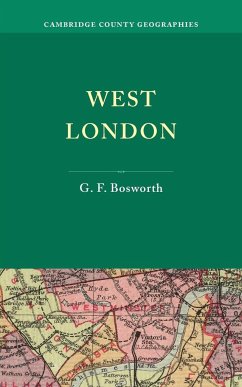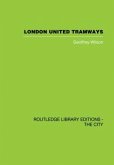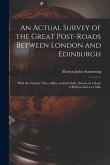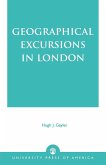G. F. Bosworth
West London
25,99 €
inkl. MwSt.
Versandfertig in 1-2 Wochen

13 °P sammeln
G. F. Bosworth
West London
- Broschiertes Buch
- Merkliste
- Auf die Merkliste
- Bewerten Bewerten
- Teilen
- Produkt teilen
- Produkterinnerung
- Produkterinnerung
This guide to West London by G. F. Bosworth was first published in 1912 as part of the Cambridge County Geographies.
Andere Kunden interessierten sich auch für
![London United Tramways London United Tramways]() Geoffrey WilsonLondon United Tramways63,99 €
Geoffrey WilsonLondon United Tramways63,99 €![A Londoner's London [microform] A Londoner's London [microform]]() A Londoner's London [microform]27,99 €
A Londoner's London [microform]27,99 €![Plan for Shortening the Time of Passage Between New York and London [microform]: With Documents Relating Thereto, Including the Proceedings of the Rai Plan for Shortening the Time of Passage Between New York and London [microform]: With Documents Relating Thereto, Including the Proceedings of the Rai]() Plan for Shortening the Time of Passage Between New York and London [microform]: With Documents Relating Thereto, Including the Proceedings of the Rai19,99 €
Plan for Shortening the Time of Passage Between New York and London [microform]: With Documents Relating Thereto, Including the Proceedings of the Rai19,99 €![From Loneland to London in 1894 [microform]: With Notes by the Way From Loneland to London in 1894 [microform]: With Notes by the Way]() Harshaw CommonFrom Loneland to London in 1894 [microform]: With Notes by the Way18,99 €
Harshaw CommonFrom Loneland to London in 1894 [microform]: With Notes by the Way18,99 €![An Actual Survey of the Great Post-roads Between London and Edinburgh: With the Country Three Miles, on Each Side, Drawn on a Scale of Half an Inch to An Actual Survey of the Great Post-roads Between London and Edinburgh: With the Country Three Miles, on Each Side, Drawn on a Scale of Half an Inch to]() Mostyn John ArmstrongAn Actual Survey of the Great Post-roads Between London and Edinburgh: With the Country Three Miles, on Each Side, Drawn on a Scale of Half an Inch to19,99 €
Mostyn John ArmstrongAn Actual Survey of the Great Post-roads Between London and Edinburgh: With the Country Three Miles, on Each Side, Drawn on a Scale of Half an Inch to19,99 €![The Illustrated London Geography [microform] The Illustrated London Geography [microform]]() Joseph GuyThe Illustrated London Geography [microform]19,99 €
Joseph GuyThe Illustrated London Geography [microform]19,99 €![Geographical Excursions in London Geographical Excursions in London]() Hugh J. GaylorGeographical Excursions in London88,99 €
Hugh J. GaylorGeographical Excursions in London88,99 €-
-
-
This guide to West London by G. F. Bosworth was first published in 1912 as part of the Cambridge County Geographies.
Hinweis: Dieser Artikel kann nur an eine deutsche Lieferadresse ausgeliefert werden.
Hinweis: Dieser Artikel kann nur an eine deutsche Lieferadresse ausgeliefert werden.
Produktdetails
- Produktdetails
- Verlag: Cambridge University Press
- Seitenzahl: 280
- Erscheinungstermin: 30. November 2012
- Englisch
- Abmessung: 203mm x 127mm x 17mm
- Gewicht: 340g
- ISBN-13: 9781107663602
- ISBN-10: 1107663601
- Artikelnr.: 37391853
- Herstellerkennzeichnung
- Libri GmbH
- Europaallee 1
- 36244 Bad Hersfeld
- gpsr@libri.de
- Verlag: Cambridge University Press
- Seitenzahl: 280
- Erscheinungstermin: 30. November 2012
- Englisch
- Abmessung: 203mm x 127mm x 17mm
- Gewicht: 340g
- ISBN-13: 9781107663602
- ISBN-10: 1107663601
- Artikelnr.: 37391853
- Herstellerkennzeichnung
- Libri GmbH
- Europaallee 1
- 36244 Bad Hersfeld
- gpsr@libri.de
1. County and shire. The county of London. The word London: its origin and
meaning; 2. General characteristics. Position and natural conditions. Why
London is our capital; 3. Size. Boundaries. Development. History of Growth.
London of the Romans, of the Saxons, of the Normans. Medieval London.
Stuart London; 4. London parks, commons, and open spaces in the NW and SW;
5. The Royal Parks - St James's Park. The Green Park. Hyde Park. Kensington
Gardens. Regent's Park; 6. The River Thames. The Embankment. The Wandle.
The bridges; 7. Rivers of the past. The Westbourne, and the Tybourne, or
Tyburn; 8. The water-supply of London - past and present; 9. Geology; 10.
Natural history; 11. Climate and rainfall. Greenwich Observatory and its
work; 12. People - race. Dialect. Settlements. Population; 13. Industries
and manufactures; 14. Trade. The markets. The Custom House. The Exchanges.
The Bank of England. The Royal Mint; 15. History; 16. Antiquities -
prehistoric, Roman, Saxon; 17. Architecture - (a) ecclesiastical. Medieval
churches. Wren's churches. Chapels Royal; 18. Architecture - (b)
ecclesiastical. Westminster Abbey; 19. Architecture - (c) domestic. Royal
and Episcopal palaces: The Tower, Westminster, Whitehall, The Savoy, St
James's, Kensington, Buckingham, Lambeth, and Fulham. Houses: Staple Inn,
Holland House, etc.; 20. Communications - ancient and modern. The Thames
formerly the Normal Highway of London. The Thames Watermen; 21.
Administration and divisions. The City of Westminster. The London County
Council. The Port Authority. Trinity House; 22. Public buildings - (a)
parliamentary and legal. The Houses of Parliament. Royal Courts of Justice.
Inns of Court; 23. Public buildings - (b) government and administrative
offices in Whitehall and Parliament Street. Somerset House. Spring Gardens;
24. Public buildings - (c) museums and exhibitions. British Museum, Natural
History Museum, Victoria and Albert Museum, India Museum, Imperial
Institute; 25. Public buildings - (d) art galleries. National Gallery,
National Portrait Gallery, National Gallery of British Art, The Wallace
Collection; 26. Public buildings - (e) hospitals. St Thomas's, St George's,
Charing Cross, Royal Military Hospital, Foundling Hospital; 27. Education -
primary, secondary, and technical. Foundation and collegiate schools. The
University of London; 28. Roll of honour; 29. The City of Westminster and
the Boroughs in the north-west and south-west of the county of London; Area
and population; Index.
meaning; 2. General characteristics. Position and natural conditions. Why
London is our capital; 3. Size. Boundaries. Development. History of Growth.
London of the Romans, of the Saxons, of the Normans. Medieval London.
Stuart London; 4. London parks, commons, and open spaces in the NW and SW;
5. The Royal Parks - St James's Park. The Green Park. Hyde Park. Kensington
Gardens. Regent's Park; 6. The River Thames. The Embankment. The Wandle.
The bridges; 7. Rivers of the past. The Westbourne, and the Tybourne, or
Tyburn; 8. The water-supply of London - past and present; 9. Geology; 10.
Natural history; 11. Climate and rainfall. Greenwich Observatory and its
work; 12. People - race. Dialect. Settlements. Population; 13. Industries
and manufactures; 14. Trade. The markets. The Custom House. The Exchanges.
The Bank of England. The Royal Mint; 15. History; 16. Antiquities -
prehistoric, Roman, Saxon; 17. Architecture - (a) ecclesiastical. Medieval
churches. Wren's churches. Chapels Royal; 18. Architecture - (b)
ecclesiastical. Westminster Abbey; 19. Architecture - (c) domestic. Royal
and Episcopal palaces: The Tower, Westminster, Whitehall, The Savoy, St
James's, Kensington, Buckingham, Lambeth, and Fulham. Houses: Staple Inn,
Holland House, etc.; 20. Communications - ancient and modern. The Thames
formerly the Normal Highway of London. The Thames Watermen; 21.
Administration and divisions. The City of Westminster. The London County
Council. The Port Authority. Trinity House; 22. Public buildings - (a)
parliamentary and legal. The Houses of Parliament. Royal Courts of Justice.
Inns of Court; 23. Public buildings - (b) government and administrative
offices in Whitehall and Parliament Street. Somerset House. Spring Gardens;
24. Public buildings - (c) museums and exhibitions. British Museum, Natural
History Museum, Victoria and Albert Museum, India Museum, Imperial
Institute; 25. Public buildings - (d) art galleries. National Gallery,
National Portrait Gallery, National Gallery of British Art, The Wallace
Collection; 26. Public buildings - (e) hospitals. St Thomas's, St George's,
Charing Cross, Royal Military Hospital, Foundling Hospital; 27. Education -
primary, secondary, and technical. Foundation and collegiate schools. The
University of London; 28. Roll of honour; 29. The City of Westminster and
the Boroughs in the north-west and south-west of the county of London; Area
and population; Index.
1. County and shire. The county of London. The word London: its origin and
meaning; 2. General characteristics. Position and natural conditions. Why
London is our capital; 3. Size. Boundaries. Development. History of Growth.
London of the Romans, of the Saxons, of the Normans. Medieval London.
Stuart London; 4. London parks, commons, and open spaces in the NW and SW;
5. The Royal Parks - St James's Park. The Green Park. Hyde Park. Kensington
Gardens. Regent's Park; 6. The River Thames. The Embankment. The Wandle.
The bridges; 7. Rivers of the past. The Westbourne, and the Tybourne, or
Tyburn; 8. The water-supply of London - past and present; 9. Geology; 10.
Natural history; 11. Climate and rainfall. Greenwich Observatory and its
work; 12. People - race. Dialect. Settlements. Population; 13. Industries
and manufactures; 14. Trade. The markets. The Custom House. The Exchanges.
The Bank of England. The Royal Mint; 15. History; 16. Antiquities -
prehistoric, Roman, Saxon; 17. Architecture - (a) ecclesiastical. Medieval
churches. Wren's churches. Chapels Royal; 18. Architecture - (b)
ecclesiastical. Westminster Abbey; 19. Architecture - (c) domestic. Royal
and Episcopal palaces: The Tower, Westminster, Whitehall, The Savoy, St
James's, Kensington, Buckingham, Lambeth, and Fulham. Houses: Staple Inn,
Holland House, etc.; 20. Communications - ancient and modern. The Thames
formerly the Normal Highway of London. The Thames Watermen; 21.
Administration and divisions. The City of Westminster. The London County
Council. The Port Authority. Trinity House; 22. Public buildings - (a)
parliamentary and legal. The Houses of Parliament. Royal Courts of Justice.
Inns of Court; 23. Public buildings - (b) government and administrative
offices in Whitehall and Parliament Street. Somerset House. Spring Gardens;
24. Public buildings - (c) museums and exhibitions. British Museum, Natural
History Museum, Victoria and Albert Museum, India Museum, Imperial
Institute; 25. Public buildings - (d) art galleries. National Gallery,
National Portrait Gallery, National Gallery of British Art, The Wallace
Collection; 26. Public buildings - (e) hospitals. St Thomas's, St George's,
Charing Cross, Royal Military Hospital, Foundling Hospital; 27. Education -
primary, secondary, and technical. Foundation and collegiate schools. The
University of London; 28. Roll of honour; 29. The City of Westminster and
the Boroughs in the north-west and south-west of the county of London; Area
and population; Index.
meaning; 2. General characteristics. Position and natural conditions. Why
London is our capital; 3. Size. Boundaries. Development. History of Growth.
London of the Romans, of the Saxons, of the Normans. Medieval London.
Stuart London; 4. London parks, commons, and open spaces in the NW and SW;
5. The Royal Parks - St James's Park. The Green Park. Hyde Park. Kensington
Gardens. Regent's Park; 6. The River Thames. The Embankment. The Wandle.
The bridges; 7. Rivers of the past. The Westbourne, and the Tybourne, or
Tyburn; 8. The water-supply of London - past and present; 9. Geology; 10.
Natural history; 11. Climate and rainfall. Greenwich Observatory and its
work; 12. People - race. Dialect. Settlements. Population; 13. Industries
and manufactures; 14. Trade. The markets. The Custom House. The Exchanges.
The Bank of England. The Royal Mint; 15. History; 16. Antiquities -
prehistoric, Roman, Saxon; 17. Architecture - (a) ecclesiastical. Medieval
churches. Wren's churches. Chapels Royal; 18. Architecture - (b)
ecclesiastical. Westminster Abbey; 19. Architecture - (c) domestic. Royal
and Episcopal palaces: The Tower, Westminster, Whitehall, The Savoy, St
James's, Kensington, Buckingham, Lambeth, and Fulham. Houses: Staple Inn,
Holland House, etc.; 20. Communications - ancient and modern. The Thames
formerly the Normal Highway of London. The Thames Watermen; 21.
Administration and divisions. The City of Westminster. The London County
Council. The Port Authority. Trinity House; 22. Public buildings - (a)
parliamentary and legal. The Houses of Parliament. Royal Courts of Justice.
Inns of Court; 23. Public buildings - (b) government and administrative
offices in Whitehall and Parliament Street. Somerset House. Spring Gardens;
24. Public buildings - (c) museums and exhibitions. British Museum, Natural
History Museum, Victoria and Albert Museum, India Museum, Imperial
Institute; 25. Public buildings - (d) art galleries. National Gallery,
National Portrait Gallery, National Gallery of British Art, The Wallace
Collection; 26. Public buildings - (e) hospitals. St Thomas's, St George's,
Charing Cross, Royal Military Hospital, Foundling Hospital; 27. Education -
primary, secondary, and technical. Foundation and collegiate schools. The
University of London; 28. Roll of honour; 29. The City of Westminster and
the Boroughs in the north-west and south-west of the county of London; Area
and population; Index.



![A Londoner's London [microform] A Londoner's London [microform]](https://bilder.buecher.de/produkte/65/65574/65574039m.jpg)
![Plan for Shortening the Time of Passage Between New York and London [microform]: With Documents Relating Thereto, Including the Proceedings of the Rai Plan for Shortening the Time of Passage Between New York and London [microform]: With Documents Relating Thereto, Including the Proceedings of the Rai](https://bilder.buecher.de/produkte/66/66184/66184207m.jpg)
![From Loneland to London in 1894 [microform]: With Notes by the Way From Loneland to London in 1894 [microform]: With Notes by the Way](https://bilder.buecher.de/produkte/66/66133/66133119m.jpg)

![The Illustrated London Geography [microform] The Illustrated London Geography [microform]](https://bilder.buecher.de/produkte/65/65624/65624394m.jpg)
